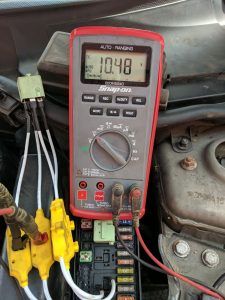PMM has enlisted Darren Cotton, of AVC UK, to attend the full range of course modules on the Bosch Diagnostic Technician Programme over the coming months. In the second instalment, Darren discusses his experience of Module VSE1: Essential Test Procedures.
The FacilityThe 2,000m2 Bosch Service Training Centre in Uxbridge has well equipped facilities in prestigious surroundings. It’s a multimillion pound investment dedicated to the aftermarket, comprising four classrooms and a large workshop area that is equipped with the latest Bosch equipment, including diagnostic equipment.
The VSE 1 course has given me a greater understanding of the fundamentals of electrics and diagnostic testing techniques. During this two-day training module we covered the following topics:
■ Electrical theory
■ Values and Ohm’s law
■ Testing series and parallel circuits (which included differences and practical tests, electrical power and volt drop testing)
■ Circuit diagrams identification and use
■ Battery starting and charging systems, operation, testing and diagnostics
At the start of the day, the training facilitator made the group feel very relaxed. During his introduction to the group, we learned that the trainer not only provides training sessions for the Bosch team, but also runs his own successful garage, therefore making him familiar with the challenges we all face in our own workshops every day.
This was very reassuring and made the training session much more relevant and specific to us all. The first activity we took part in involved the principals of electricity. This concept was demonstrated using a tank of water to show the relationship between voltage, current and resistance. By breaking down the concept into a visual demonstration, it made the learning process easier. We then moved onto Ohm’s law. Even though we do not always use this theory in our workshop day-to-day, it is an integral factor that underpins many of the processes connected with making measurements, so it was very helpful to cover this topic again to make sure our understanding was embedded.
Next up was electrical test procedures using a multi-meter. The group was split in two and we began practical tasks. Each group was given the same demonstration circuit test boards. Using a multi-meter supplied to us, we started with some simple circuit measuring and recorded our findings in our worksheets inside the course booklet, and we had the opportunity to discuss the findings as a whole group. I found this section of the training particularly useful as the method used to demonstrate the principal behind the circuit testing was broken down into four simple tests that can be undertaken using a multimeter.
 This made a complex concept much easier to grasp – a common feature of the Bosch training programme. Wiring diagrams are often complicated to follow, but this part of the session was very interesting indeed. The training facilitator displayed a modern engine management wiring diagram and explained the control and load elements of a circuit, as well as the symbols and terminology. The trainer made this an interactive activity, which was very well received by everyone in the group.
This made a complex concept much easier to grasp – a common feature of the Bosch training programme. Wiring diagrams are often complicated to follow, but this part of the session was very interesting indeed. The training facilitator displayed a modern engine management wiring diagram and explained the control and load elements of a circuit, as well as the symbols and terminology. The trainer made this an interactive activity, which was very well received by everyone in the group.
In the well-equipped on-site workshop, we got a chance to put the classroom theory into practice, analysing volt drop on a starter motor and alternator circuit, measuring current on a starter, and putting into practice the four key tests on a circuit. Each delegate did the same test and the trainer made sure we all understood the operation correctly. The rest of the session involved many other topics, including: circuit components, wiring diagram analysis, battery types and technology, essential characteristics and fault diagnosis of a battery, typical starter motor operations, alternator operating principles and smart charging.
The two-day programme was very interesting. I think I’ve gained a lot of knowledge from this course and I found the training facilitator very knowledgeable. He made sure throughout the sessions that every delegate understood each topic before moving on and everyone felt comfortable asking questions in the relaxed atmosphere within the classroom. My highlight of this particular module was being shown the importance of volt drop testing, making and keeping things simple using four simple circuit tests and how to correctly navigate my way round a circuit diagram. This is a course well worth doing, even if you are very familiar with vehicle electrics. Sometimes it’s the basics we forget and this course reminded me of the importance of keeping your knowledge refreshed.
Back at my workshop, I quickly got the opportunity to put the volt drop test to work on a non-starting Mini (R56) with low voltage supply to the Engine Control Unit. Once the control side of the relay was confirmed as being in good order (pins 85 and 86 of the relay) I tested the load side. Fig 1 displays the volt drop across the load side of the engine control relay (pins 30 and 87 engine cranking) which helped me prove that the relay was at fault, causing a 10.5V drop.
Module: VSE1: Essential Test Procedures
The Bosch Diagnostic Technician (BDT) Programme comprises one-day and two-day course modules covering various automotive topics. The BDT programme is suitable for technicians with some prior diagnostic experience and is ideal for those who wish to develop into vehicle system specialists. The programme is approved by the IMI, under the Quality Assured Programmes scheme, as a nationally recognised Level 3 accreditation.











